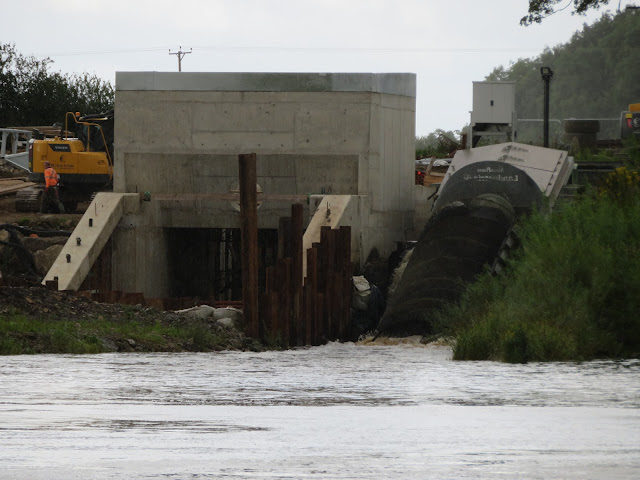Our time in York had come to an end and we were off by 0900 as we had plenty of ground to cover today and the weather was to be mixed.
Just as I was letting go it started to rain, not too heavily, but I could see blue sky so it seemed that we were in for a day of sunshine and showers. It was also blowing a bit, so I was glad I was on the river rather than a narrow, shallow canal going slowly. The Scarborough Railway Bridge was the second bridge across the Ouse in York in 1845. It carries the line to Scarborough and was twin track with a footpath between them. The decks were completely replaced in 2015 and the footpath is now on the south east side.
The York Rowing Club just by Lendal Bridge seems to get going with training by about 0700 and there were plenty about when we started to leave York behind. It seems that they stayed with us until the next railway bridge that carries the East Coast Main Line about 3.5 miles upstream.
The passing black clouds were a great contrast to the searchlight suns rays on parts of the river.
Just by Nun Monkton was this lovely rigged dutch boat, even with sails rigged. We saw nothing of Beningbrough Hall as the banks were too high and the trees too thick.
As we rounded the grounds of Beningbrough Hall and approached Newton on Ouse we passed the water tower of the big house and also the river narrowed making it seem more like the Avon rather than the Thames.
At Linton Lock there are big shallows where the weir, to the left flows round the bend, and they are marked by several red buoys. The lock can be seen to the right. The building on the lock island between is not a mill, as you may think, but a hydro electic power station that was built in the 1920's and supplied York. It only stopped producing in the 1960's when it became unprofitable due to taxation.
The weir was built in about 1769 along with a salmon ladder in 1894. With the failure of the hydro station and the fact that we know more about fish and the old salmon ladder is not very fish friendly. Mann Hydropower, leaders in the field of Archimedes screw generating units installed a screw here in 2012 of 100KW. Last year another was installed of 280KW and all can be remotely monitored. The new fish ladder they are building will also act as the route for canoeists to get over the weir.
The water point is on the floating pontoon before the lock. There is a lock landing just before the lock but was just emerging from the water. The navigation was designed by John Smeaton, of Eddystone Lt. Ho. fame and was engineered by William Jessop. The gates are at a bit of a slant so they are quite difficult to get moving. You can also see that the lock sides slope inwards at the bottom too.
Aldwark Toll Bridge is over 200 years old but saves a 25 mile detour. It costs 40p if you pay 'on the door', but 35p if in advance. The deck appears to be wooden still. The ownership of the bridge changed hands in 2015 and they put the toll up from 25p!
Not far upstream is the point that the River Ouse becomes the River Ure. This is at the point that the Ouse Gill Beck joins the main river, but I wasn't able to spot it. The Ouse Gill beck is so small it doesn't reveal itself. However the River Ure seems more like the Thames just at this point.
Shortly after the last photo you get to this point near Aldborough where the river narrows and you start to think you may have taken a wrong turn! The river does go to the left.
We are near the end of the days journey as we arrive at the Milby Lock. We were surprised to find a voluntary lock keeper on duty. He was pleased to see us too as he had been quiet all day. C&RT were mending fences at the lock and there was even a boat waiting to come down. It had got very busy for him.
The boat coming down was this fishing skiff with a couple of anglers aboard. The gates are heavy on the river section as they have to be large to work at all river levels.
The cut from the lock to Boroughbridge visitor moorings seems to be tunnel like as the trees seem to meet up above the water. We had our fingers crossed that there would be room on the moorings as there was a way to go to the next one. There were two cruisers alongside but still plenty of space for us.














No comments:
Post a Comment